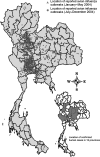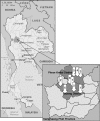Evidence for subclinical avian influenza virus infections among rural Thai villagers
- PMID: 21921216
- PMCID: PMC3174099
- DOI: 10.1093/cid/cir525
Evidence for subclinical avian influenza virus infections among rural Thai villagers
Abstract
Background: Regions of Thailand reported sporadic outbreaks of A/H5N1 highly pathogenic avian influenza (HPAI) among poultry between 2004 and 2008. Kamphaeng Phet Province, in north-central Thailand had over 50 HPAI poultry outbreaks in 2004 alone, and 1 confirmed and 2 likely other human HPAI infections between 2004 and 2006.
Methods: In 2008, we enrolled a cohort of 800 rural Thai adults living in 8 sites within Kamphaeng Phet Province in a prospective study of zoonotic influenza transmission. We studied participants' sera with serologic assays against 16 avian, 2 swine, and 8 human influenza viruses.
Results: Among participants (mean age 49.6 years and 58% female) 65% reported lifetime poultry exposure of at least 30 consecutive minutes. Enrollees had elevated antibodies by microneutralization assay against 3 avian viruses: A/Hong Kong/1073/1999(H9N2), A/Thailand/676/2005(H5N1), and A/Thailand/384/2006(H5N1). Bivariate risk factor modeling demonstrated that male gender, lack of an indoor water source, and tobacco use were associated with elevated titers against avian H9N2 virus. Multivariate modeling suggested that increasing age, lack of an indoor water source, and chronic breathing problems were associated with infection with 1 or both HPAI H5N1 strains. Poultry exposure was not associated with positive serologic findings.
Conclusions: These data suggest that people in rural central Thailand may have experienced subclinical avian influenza infections as a result of yet unidentified environmental exposures. Lack of an indoor water source may play a role in transmission.
Figures


Similar articles
-
Prospective study of avian influenza virus infections among rural Thai villagers.PLoS One. 2013 Aug 16;8(8):e72196. doi: 10.1371/journal.pone.0072196. eCollection 2013. PLoS One. 2013. PMID: 23977250 Free PMC article.
-
Live poultry market workers are susceptible to both avian and swine influenza viruses, Guangdong Province, China.Vet Microbiol. 2015 Dec 31;181(3-4):230-5. doi: 10.1016/j.vetmic.2015.09.016. Epub 2015 Sep 25. Vet Microbiol. 2015. PMID: 26476563 Free PMC article.
-
Avian influenza surveillance reveals presence of low pathogenic avian influenza viruses in poultry during 2009-2011 in the West Bengal State, India.Virol J. 2012 Aug 7;9:151. doi: 10.1186/1743-422X-9-151. Virol J. 2012. PMID: 22867041 Free PMC article.
-
Highly pathogenic avian influenza H5N1, Thailand, 2004.Emerg Infect Dis. 2005 Nov;11(11):1664-72. doi: 10.3201/eid1111.050608. Emerg Infect Dis. 2005. PMID: 16318716 Free PMC article. Review.
-
Avian influenza infections in birds--a moving target.Influenza Other Respir Viruses. 2007 Jan;1(1):11-8. doi: 10.1111/j.1750-2659.2006.00004.x. Influenza Other Respir Viruses. 2007. PMID: 19459279 Free PMC article. Review.
Cited by
-
Seroprevalence of antibodies against highly pathogenic avian influenza A (H5N1) virus among poultry workers in Bangladesh, 2009.PLoS One. 2013 Sep 5;8(9):e73200. doi: 10.1371/journal.pone.0073200. eCollection 2013. PLoS One. 2013. PMID: 24039887 Free PMC article.
-
Global epidemiology of avian influenza A H5N1 virus infection in humans, 1997-2015: a systematic review of individual case data.Lancet Infect Dis. 2016 Jul;16(7):e108-e118. doi: 10.1016/S1473-3099(16)00153-5. Epub 2016 May 17. Lancet Infect Dis. 2016. PMID: 27211899 Free PMC article.
-
Replication of H9 influenza viruses in the human ex vivo respiratory tract, and the influence of neuraminidase on virus release.Sci Rep. 2017 Jul 24;7(1):6208. doi: 10.1038/s41598-017-05853-5. Sci Rep. 2017. PMID: 28740108 Free PMC article.
-
Genetic Adaptation of Influenza A Viruses in Domestic Animals and Their Potential Role in Interspecies Transmission: A Literature Review.Ecohealth. 2016 Mar;13(1):171-98. doi: 10.1007/s10393-014-1004-1. Epub 2015 Jan 29. Ecohealth. 2016. PMID: 25630935 Review.
-
Intense circulation of A/H5N1 and other avian influenza viruses in Cambodian live-bird markets with serological evidence of sub-clinical human infections.Emerg Microbes Infect. 2016 Jul 20;5(7):e70. doi: 10.1038/emi.2016.69. Emerg Microbes Infect. 2016. PMID: 27436362 Free PMC article.
References
-
- Tiensin T, Nielen M, Vernooij H, et al. Transmission of the highly pathogenic avian influenza virus H5N1 within flocks during the 2004 epidemic in Thailand. J Infect Dis. 2007;196:1679–84. - PubMed
-
- Buranathai C, Amonsin A, Chaisigh A, Theamboonlers A, Pariyothorn N, Poovorawan Y. Surveillance activities and molecular analysis of H5N1 highly pathogenic avian influenza viruses from Thailand, 2004–2005. Avian Dis. 2007;51(Suppl 1):194–200. - PubMed
-
- Tiensin T, Nielen M, Songserm T, et al. Geographic and temporal distribution of highly pathogenic avian influenza A virus (H5N1) in Thailand, 2004–2005: An overview. Avian Dis. 2007;51(Suppl 1):182–8. - PubMed

